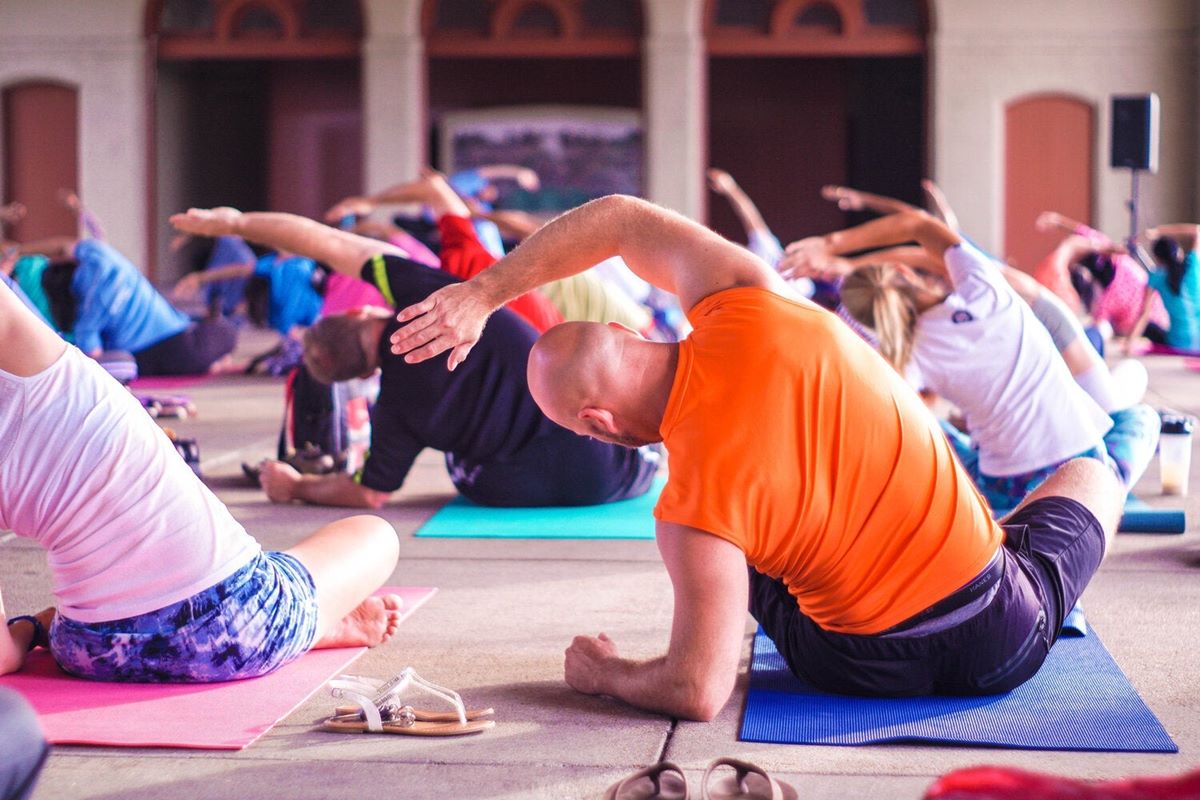

Featured
How To Build Up Walking Endurance
Modified: January 2, 2024
Looking to build up your walking endurance? Check out our featured guide on how to increase your stamina and go the extra mile.
Introduction
Welcome to the world of walking! Walking is a simple yet effective form of exercise that can help improve your overall health and wellbeing. Whether you are a beginner or someone looking to increase your walking endurance, this article will provide you with valuable insights and tips to help you reach your goals.
Walking offers a multitude of benefits, both physical and mental. It is a low-impact exercise that can be done by people of all ages and fitness levels. Regular walking can help strengthen your muscles, improve cardiovascular health, and enhance your endurance. Additionally, it can boost your mood, reduce stress, and increase your energy levels.
However, building up walking endurance takes time and effort. It’s important to start slow and gradually increase your distance and intensity to avoid injury and burnout. The key is to set realistic goals, stay consistent, and listen to your body.
In this article, we will explore various strategies to help you build up your walking endurance. From setting goals to incorporating interval training, we will cover everything you need to know to maximize your walking potential. So put on your walking shoes and let’s get started on this journey to a fitter, healthier you!
Benefits of Walking
Walking offers a wide range of benefits for your physical and mental well-being. Incorporating regular walks into your routine can have a positive impact on your overall health. Let’s explore some of the key benefits:
- Improved cardiovascular health: Walking is a great way to improve your heart health. It increases your heart rate, strengthens your heart muscles, and promotes better blood circulation. Regular walking can help reduce the risk of heart disease, lower blood pressure, and improve cholesterol levels.
- Weight management: Walking is an effective form of exercise for weight management. It helps burn calories, increase metabolism, and promote fat loss. Walking regularly, combined with a balanced diet, can help you maintain a healthy weight or support weight loss goals.
- Increased endurance: Walking is an excellent way to build endurance and stamina. As you gradually increase your walking distance and duration, your body becomes more efficient at delivering oxygen to your muscles, enhancing your overall endurance levels.
- Muscle strength and tone: Walking engages various muscle groups in your body, including your legs, buttocks, core, and arms. Regular walking can help tone and strengthen these muscles, leading to improved posture and overall muscle strength.
- Joint health: Contrary to high-impact activities, walking is a low-impact exercise that puts less stress on your joints. It is an ideal choice for individuals with joint problems or those who are recovering from injuries. Walking can help improve joint flexibility, reduce stiffness, and alleviate arthritis symptoms.
- Mental well-being: Walking has numerous mental health benefits. It releases endorphins, also known as “feel-good” hormones, which can boost your mood and reduce stress, anxiety, and symptoms of depression. Walking outdoors in nature can also have a calming and rejuvenating effect on your mind.
These are just a few of the many benefits that walking can provide. By incorporating regular walks into your daily routine, you can enhance your physical fitness, mental clarity, and overall quality of life.
Setting Goals
Setting clear and achievable goals is an important first step in building up your walking endurance. Goals provide direction, motivation, and a sense of accomplishment as you progress. Here are some tips for setting effective walking goals:
- Be specific: Instead of a vague goal like “I want to walk more,” be specific about what you want to achieve. For example, “I will walk for 30 minutes, five days a week.”
- Make it measurable: Set goals that can be measured and tracked. This allows you to monitor your progress and make adjustments if needed. For instance, you can track the number of steps taken, distance covered, or time spent walking.
- Start small: It’s important to start with realistic goals that are achievable for your current fitness level. Gradually increase the difficulty as you progress. For beginners, a goal of walking for 15-20 minutes, three times a week, is a good starting point.
- Set a timeline: Establish a timeline for achieving your goals. This adds a sense of urgency and helps you stay focused. Choose a timeline that is realistic and allows for gradual progression.
- Reward yourself: Celebrate your achievements along the way. Set up small rewards for reaching milestones, such as treating yourself to a massage or buying a new pair of walking shoes.
Remember, goals should be challenging but attainable. They should push you out of your comfort zone without causing unnecessary strain or risk of injury. Break down your long-term goals into smaller, achievable steps, and celebrate each milestone reached.
By setting clear and measurable goals, you will have a roadmap to guide your walking journey and help you stay motivated and focused on improving your endurance levels.
Starting with Short Distances
When building up your walking endurance, it’s important to start with short distances and gradually increase your walking time and intensity. This allows your body to adjust and adapt to the increased demands placed on it. Here are some tips to get started:
- Warm up: Before each walking session, take a few minutes to warm up your muscles and prepare your body for exercise. Perform light dynamic stretches or take a brisk walk for 5-10 minutes to increase blood flow to your muscles.
- Choose comfortable footwear: Invest in a good pair of walking shoes that provide proper support and cushioning. Ill-fitting shoes can cause discomfort and increase the risk of injury. Remember to wear moisture-wicking socks to keep your feet dry and blister-free.
- Start slow: Begin your walking routine with a comfortable pace and shorter distances. Aim for 10-15 minutes of continuous walking at a pace where you can still hold a conversation without feeling too breathless.
- Listen to your body: Pay attention to any discomfort or pain during your walks. If you experience any unusual pain or excessive fatigue, take a break and consult a healthcare professional if necessary. It’s important to give your body time to adapt and avoid overexertion.
- Incorporate rest days: Allow your body time to recover and adapt by incorporating rest days into your walking routine. Rest days help prevent overuse injuries and give your muscles time to repair and grow stronger.
As you progress and feel comfortable with your initial distance and pace, gradually increase your walking time or distance. Aim to add a few minutes or a few hundred steps each week to challenge yourself without pushing too hard.
Remember, building up endurance takes time and consistency. Be patient with yourself and celebrate small milestones along the way. Before you know it, those short distances will turn into longer and more rewarding walking sessions.
Gradually Increasing Distance
As you become comfortable with walking shorter distances, it’s time to gradually increase your distance to build up your walking endurance. By progressively challenging your body, you can improve your stamina and go the extra mile. Here are some tips to help you gradually increase your walking distance:
- Add a few minutes: Start by adding a few minutes to your walking time each week. For example, if you’ve been walking for 20 minutes, increase it to 25 minutes the following week. Slowly work your way up until you reach your desired time goal.
- Extend one walk per week: Choose one walk per week where you increase the distance more significantly. For instance, if you typically walk 2 miles, add an extra half-mile or mile to that particular walk. This allows you to challenge yourself and gradually build up your endurance.
- Interval training: Incorporate intervals of faster-paced walking or jogging into your routine. This helps to increase your heart rate and intensity, providing an additional challenge to your muscles and cardiovascular system. Start with short bursts of speed and gradually increase the duration as you progress.
- Explore different routes: Keep things interesting by exploring new routes or trails. Walking in different environments and terrains can naturally increase your distance. It also adds variety to your routine and keeps you mentally engaged and motivated.
- Listen to your body: Pay attention to any signs of fatigue or discomfort. It’s important to challenge yourself, but not at the expense of your health. Take rest days or decrease your distance if you’re feeling excessively tired or experiencing any pain or injuries.
Remember to pace yourself and be patient with the process. Gradually increasing your walking distance allows your body to adapt and build endurance safely. Celebrate each milestone reached and acknowledge the progress you’ve made along the way.
By implementing these strategies, you will gradually increase your walking distance and continue to build up your endurance, taking you closer to your ultimate goals.
Incorporating Interval Training
In addition to gradually increasing your walking distance, incorporating interval training into your routine can be a powerful strategy to improve your walking endurance. Interval training involves alternating periods of higher intensity with periods of lower intensity or active recovery. Here’s how you can incorporate interval training into your walking regimen:
- Warm-up: Begin with a 5-10 minute warm-up of brisk walking to get your muscles and cardiovascular system ready for the upcoming intervals.
- Intervals: Choose a landmark or set a timer to signal the start of each interval. Speed up your pace to a challenging but sustainable level for a designated period, such as 1-2 minutes. This should be a pace that feels significantly more intense than your normal walking pace.
- Active recovery: After each interval, transition into a period of active recovery by walking at a slower pace or even stopping for a brief moment to catch your breath. Allow your heart rate to lower and your breathing to normalize before starting the next interval.
- Repeat: Continue alternating between intervals and active recovery for a predetermined number of times or until you complete your desired walking duration.
- Cool down: Finish your interval session with a 5-10 minute cool-down, gradually reducing your pace and allowing your body to recover.
Interval training challenges your cardiovascular system, increases your calorie burn, and helps build endurance more efficiently than steady-state walking. It also adds variety to your workouts, making them more engaging and enjoyable.
As you progress, you can adjust the duration and intensity of your intervals. Start with shorter interval times and gradually increase them as your fitness level improves. You can also alternate between different interval lengths to challenge your body in various ways.
Remember to listen to your body and rest when needed. Interval training can be intense, so it’s important to give yourself adequate recovery time between sessions. Avoid overdoing it, and gradually build up the intensity and duration of your intervals over time.
By incorporating interval training into your walking routine, you can push your endurance limits and make significant strides towards building up your walking stamina.
Building Strength and Stamina
Building strength and stamina is crucial for improving your walking endurance. By focusing on strengthening your muscles and enhancing your overall fitness, you can walk longer distances and maintain a steady pace. Here are some strategies to help you build strength and stamina:
- Incorporate resistance training: Adding resistance exercises to your routine can help strengthen the muscles involved in walking. Include exercises like squats, lunges, calf raises, and leg presses to target your lower body muscles. Strengthening your core and upper body with exercises like planks, push-ups, and overhead presses can also improve your posture and stability while walking.
- Add cross-training activities: Engaging in other forms of exercise such as swimming, cycling, or yoga can help improve your overall fitness and enhance your walking endurance. These activities work different muscle groups and provide variety to your routine.
- Increase your walking intensity: Incorporate intervals of brisk walking or uphill walking during your sessions to challenge your cardiovascular system and build stamina. This helps simulate real-life scenarios where you may encounter hills or uneven terrain during your walks.
- Include strength-focused walking workouts: Mix in strength-focused walking workouts to your routine. This can involve walking with light hand weights, using resistance bands, or walking uphill or on sandy surfaces to engage more muscles and increase the difficulty of your walks.
- Focus on proper form: Pay attention to your walking posture and technique. Keep your head up, shoulders relaxed, and core engaged. Swing your arms naturally, and maintain a heel-to-toe foot strike. Adopting a proper form while walking helps minimize the strain on your muscles and maximizes energy efficiency.
- Stay consistent: Consistency is key when building strength and stamina. Aim to walk regularly, gradually increasing your distances and intensities. Even on days when you may not feel motivated, try to get out for a shorter walk to maintain your momentum.
Building strength and stamina takes time, so be patient with the process. Focus on making incremental improvements and challenging yourself gradually. Listen to your body and remember to give yourself adequate rest and recovery to avoid overtraining and injuries.
By incorporating these strategies into your routine, you’ll build the strength and stamina needed to tackle longer, more challenging walking sessions and reach new levels of endurance.
Monitoring Progress
Monitoring your progress is essential when building up your walking endurance. It allows you to track your improvements, stay motivated, and make necessary adjustments to your routine. Here are some effective ways to monitor your progress:
- Keep a walking journal: Maintain a journal or use a fitness tracking app to log your walks. Record important details such as distance covered, time taken, average speed, and how you felt during and after each session. This provides a tangible record of your progress and helps you identify patterns or areas for improvement.
- Use a pedometer or fitness tracker: Wear a pedometer or use a fitness tracker to count your steps and track your daily activity. This allows you to set step goals and monitor your overall activity level throughout the day.
- Track your heart rate: Using a heart rate monitor can provide valuable insights into the intensity of your walks. Aim for a target heart rate range that indicates you are working at an appropriate intensity level for improving endurance.
- Measure walking time and distance: Use a stopwatch, smartphone app, or GPS watch to track the time and distance of your walks accurately. This helps you set goals, monitor progress, and plan your walking sessions effectively.
- Assess how you feel: Pay attention to how you feel during and after your walks. Take note of any improvements in your breathing, energy levels, or level of fatigue. If you notice positive changes, it’s a clear indication that you’re making progress.
- Regularly check your walking speed: Measure your walking speed over a known distance to assess if you’re increasing your pace over time. A faster walking speed indicates improved endurance and fitness levels.
Continuously monitoring your progress allows you to celebrate your achievements, identify areas that need improvement, and evaluate the effectiveness of your training program. It can also help you set new goals and adjust your walking routine as necessary to keep challenging yourself.
Remember that progress is not always linear, and there may be ups and downs along the way. Don’t be disheartened by temporary setbacks or plateaus. Consistency and perseverance will ultimately lead to improvements in your walking endurance.
By monitoring your progress and staying aware of your achievements, you’ll be motivated to push further and achieve new milestones in your journey towards increased endurance.
Staying Motivated
Staying motivated is key to building and maintaining your walking endurance. While starting a new routine can be exciting, it’s natural to experience moments of discouragement or lack of motivation along the way. Here are some strategies to help you stay motivated on your journey:
- Set realistic and achievable goals: Set goals that are challenging yet attainable. Break them down into smaller milestones to make them more manageable. Celebrate each achievement to reinforce your progress and keep your motivation high.
- Find a walking buddy: Walking with a friend or joining a walking group can make your walks more enjoyable and provide mutual support. Having a walking buddy can provide accountability and make your walking sessions more social and fun.
- Reward yourself: Set rewards for reaching specific milestones or completing a certain number of walks. Treat yourself to something you enjoy, like a massage, a new workout outfit, or a favorite healthy snack. Rewards can serve as incentives to keep you motivated and give you something to look forward to.
- Switch up your routine: Variety is key to staying motivated. Explore different walking routes, try new walking trails, or change up the scenery. You can also incorporate different challenges or themes into your walks, such as walking for a cause or participating in virtual races.
- Listen to music or podcasts: Create a motivating playlist or listen to podcasts or audiobooks during your walks. Engaging audio content can distract you from fatigue, keep your mind occupied, and make the time go by faster.
- Track your progress visually: Create a visual representation of your progress, such as a chart or a graph. This visual reminder of how far you’ve come can be highly motivating and inspire you to keep pushing forward.
- Practice self-care: Take care of your overall well-being by getting enough sleep, maintaining a balanced diet, and managing stress. When you prioritize self-care, you’ll have the energy and mental clarity to stay motivated and committed to your walking routine.
Remember that motivation can fluctuate, and it’s normal to have off days. Be kind to yourself and don’t dwell on setbacks. Focus on the positive changes you’ve already made and the benefits you’ve experienced from walking regularly.
Lastly, remember that building endurance is a gradual process, and results may not happen overnight. Stay patient, stay consistent, and celebrate every step forward on your journey to a stronger, fitter, and more resilient self.
Seeking Professional Guidance
While walking is a safe and accessible form of exercise, seeking professional guidance can provide valuable insights and ensure that you’re on the right track to building up your walking endurance. Here’s how a professional can help:
- Consult with a fitness trainer: A certified fitness trainer can assess your current fitness level, help set realistic goals, and create a customized walking program tailored to your needs. They can guide you on proper technique, provide variety in your workouts, and offer advice to prevent injuries.
- Work with a physical therapist: If you have any underlying health conditions, injuries, or concerns, consulting with a physical therapist can be beneficial. They can assess your physical abilities, provide specific exercises or stretches to address any imbalances or weaknesses, and guide you through a safe and effective progression plan.
- Seek advice from a nutritionist or dietitian: Proper nutrition plays a crucial role in supporting your walking endurance. Consulting with a nutritionist or dietitian can help ensure you’re fueling your body with the right balance of nutrients to optimize your performance and recovery.
- Join a walking group or club: Being part of a walking group or club led by experienced coaches or instructors can provide you with a supportive community. They can offer guidance, training programs, and motivational support to help you reach your walking endurance goals.
- Consider wearable technology: Investing in a wearable device, such as a heart rate monitor or fitness tracker, can provide additional guidance and insights into your walking progress. These devices can track important metrics like heart rate, distance, pace, and steps, helping you monitor your intensity levels and progress.
Remember, seeking professional guidance doesn’t mean you’re incapable of achieving your goals on your own. It shows your commitment to your well-being and ensures that you’re following a safe and effective approach to building your walking endurance.
Professional guidance can provide valuable insights, accountability, and support throughout your journey. They can also help you navigate any challenges, setbacks, or plateaus you may encounter, ensuring you continue making progress towards your goals.
Always consult with a healthcare professional before making any significant changes to your exercise routine, especially if you have underlying health conditions or concerns.
By seeking professional guidance, you can maximize the benefits of walking, reduce the risk of injury, and optimize your chances of successfully building and maintaining your walking endurance.
Conclusion
Congratulations on embarking on your journey to build up your walking endurance! Walking is a versatile and accessible form of exercise that can benefit your physical health, mental well-being, and overall quality of life. By following the strategies outlined in this article, you can take your walking routine to the next level and achieve your endurance goals.
Remember to start with short distances, gradually increase your walking time and intensity, and incorporate interval training to challenge your body and build stamina. Focus on building strength, monitoring your progress, and staying motivated throughout your journey.
Setting realistic goals, seeking professional guidance when needed, and staying consistent are all key to success. Listen to your body, adjust your routine as necessary, and celebrate every milestone reached. Even on days when motivation is low, remind yourself of the countless benefits that walking provides.
As you continue to build up your walking endurance, prioritize self-care and make walking a part of your daily routine. The journey to increased endurance may have its ups and downs, but with dedication, patience, and perseverance, you will not only achieve your walking goals but also experience improvements in your overall fitness, strength, and stamina.
So lace up your walking shoes, embrace the challenge, and enjoy the many physical, mental, and emotional rewards that come with building up your walking endurance. Here’s to a stronger, fitter, and more resilient you!









